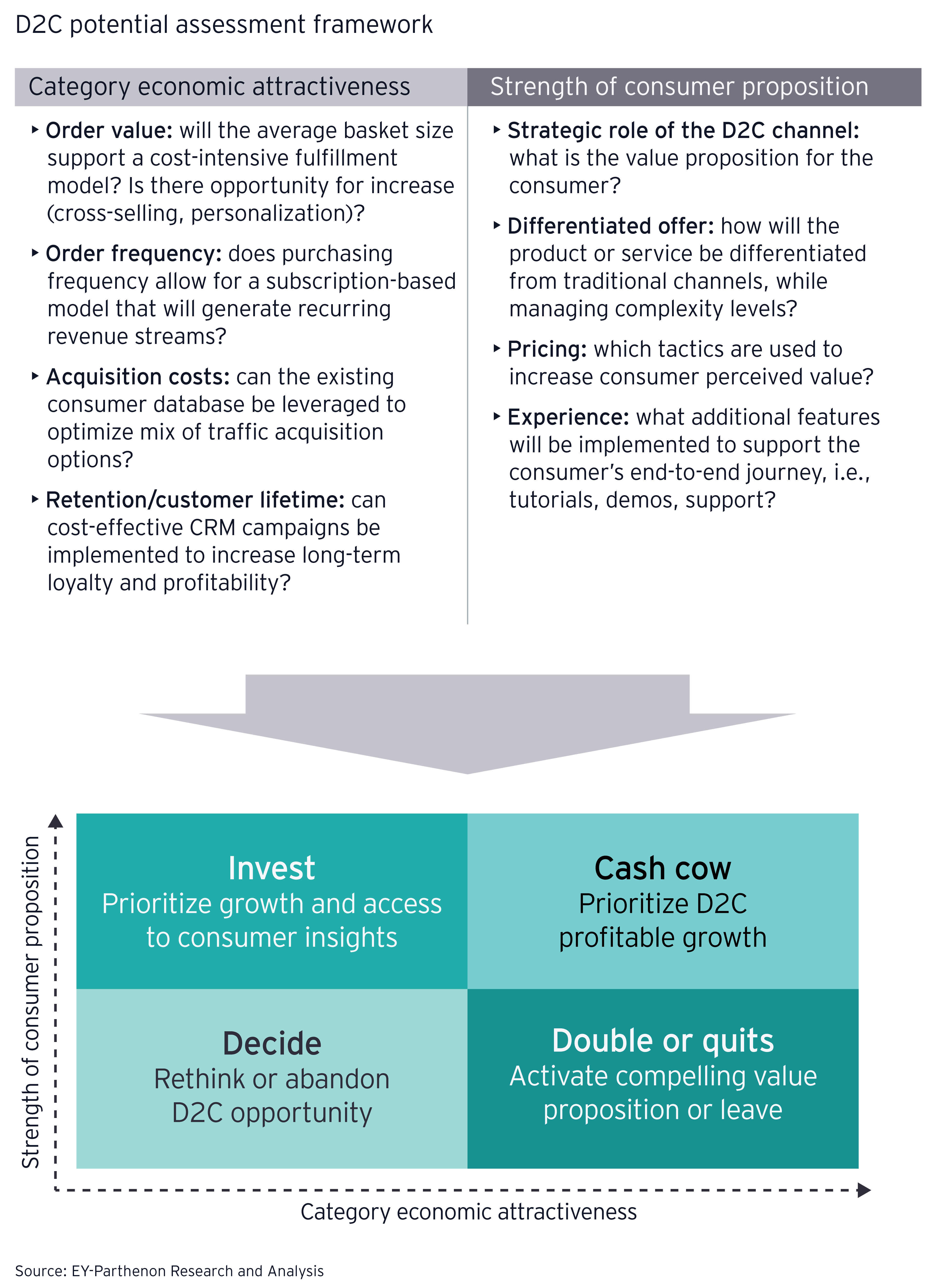
Chapter 1
Understanding the challenges
The rationale for launching online D2C strategies has never been stronger, but the challenges for doing so successfully have also deepened.
Understanding which categories are likely to be most successful, and how to implement effective governance, operations, supply chains and data management are hurdles that consumer product companies must overcome. These considerations are further complicated by variations among countries in issues such as privacy law, consumer attitudes and the cost of doing business: what works well in one market may fail in another.
In particular, the crisis has accelerated two long-term problems that consumer product companies face to achieve success with an online D2C model: poor product choices and consumer value propositions, and a limited understanding of creating profitable channels.
First, in the rush to compete in the e-commerce space and capture a “fair share” of the market, some businesses have poured money into ill-conceived online D2C projects. Although we have seen a significant culling of weak product lines by many organizations – and a strengthening of other offerings – it demonstrates that an understanding of which lines of business and consumer value propositions are best suited to online D2C remains elusive. For example, many have failed to sufficiently engage and incentivize consumers in sufficient numbers to bypass traditional retailers by developing compelling offers and brand experiences. Without a solid grasp of the fundamental economics behind such choices, the winners of today could well be the losers of tomorrow.
Second, many businesses have demonstrated the limits of their knowledge when it comes to making this business model profitable. For example, most start-up online D2C brands over the past few years have focused almost exclusively on growth to gain market share. The assumption has been that profitability would follow. When sales plummet, the pay-to-play model breaks down. With little money to meet the exorbitantly high costs of online consumer acquisition, traffic to those websites dries up – reportedly during the COVID-19 crisis by between 25% and 90% in some cases.4 Profitability needs to move more center stage in online D2C strategies. Our research shows that online D2C channels can comfortably achieve a 15% to 25% profit after operating costs – including those relating to marketing, consumer engagement, and supply chain.
Online D2C tends to account for up to 15% of a brand’s total sales depending on categories and geographies, according to our analysis. If businesses are not already achieving those levels of sales, online D2C represents a significant driver for growth.
Deciding where to play
The strongest online D2C models closely match the economic attractiveness of the product on offer with the strength of the consumer value proposition. Working critically through our D2C business assessment framework should help organizations decide where to play. The constraints involved will differ from sector to sector. For example, while food and beverage products may pass the size test, they are often low value, and items that are perishable pose logistical challenges. Even so, companies do prosper in this sector. For example, a famous snack and beverages multinational successfully launched two online D2C platforms targeting specific consumer trends that emerged during the pandemic’s lockdown period within 30 days.


Chapter 2
Winning in online D2C
Successfully competing in this field demands the implementation of a dedicated and agile online D2C operating model.
Traditionally, consumer product companies have faced operational problems with implementing online D2C channels because they significantly alter business and operating models. First, they remove the distribution intermediary – the retailer – and replace it with a complex, direct model that serves many people. The business must deal with an omni-channel strategy, be able to forecast demand, create bespoke supply chain and delivery processes, as well as handling payments, return management and customer communication. Second, it requires a shift away from marketing campaigns that are primarily designed to increase brand awareness to those that directly encourage consumers to purchase goods from the company’s online outlets – ideally becoming brand ambassadors in the process. This shift regards consumers as long-term assets worthy of investment.
Successful online D2C strategies must manage the double complexity that these challenges present, while also meeting the high expectations that have been created by digitally native vertical brands: short delivery times, personalized consumer relationships, frequently renewed products and service offerings, purpose-led visions and socially sensitive propositions.
There is no easy answer to these challenges. Depending on the organization’s strategic agenda, e-commerce maturity and financial resources, we believe that there are four online direct routes to consumer that can achieve profitability and growth. They involve different levels of operational outsourcing and partnership building. The simplest model involves the consumer product company putting its online catalog on an existing marketplace, such as Amazon or Alibaba. Alternatively, the business can open its own webstore, but rely on retail partners for distribution. D2C strategies can entail creating a webstore with distribution and fulfilment provided by logistics partners or launching a full-stack D2C channel. In each case the key to success involves harnessing online sales channels with a relevant supply chain and distribution model supported by a fully integrated, data-driven infrastructure (see Four possible online direct to consumer models).

While there is no one-size-fits all solution for creating online D2C channels, mastering the following disciplines is critical, whichever model you choose.
Mindset and talent
Consumer products companies must understand that the new channel is effectively a vertical retailer in its own right. This entails significant change in mindset best embodied by agile working practices and the creation of new strategic roles within the business staffed by people with deep experience in online D2C. For example, when the shoemaker Birkenstock Digital GMhB recruited 45 people for its D2C initiative, it favored those with backgrounds in ecommerce and digital expertise over those with deep experience in the shoe industry.5 Nike’s acquisition of Zodiac predictive analytics group enabled the business to support multiple D2C teams with core technical expertise as its offerings matured.6 Training must be geared to specific retail capabilities, including promotion, loyalty programs and sales – and dealing with the integration of new partners. Creating the right teams with consumer-centric mindsets and skills will enable the business to engage and incentivize consumers by developing compelling offers and brand experiences.
Partners and ecosystems
Businesses must continue to nurture and strengthen relationships with retailers and look to build ecosystems. Being sensitive to the needs of existing retail partnerships means clearly distinguishing online and offline products and promotions. In some instances, selling direct to the consumer with a click-and-collect process at a retail partner may be more attractive and cost-effective than building a model that delivers the goods to the consumers’ homes. The US beverage retailer Drizly has adopted such an approach.
Since online D2C platforms generate more insight into consumer behavior, it is often possible to build an ecosystem of services around a core offering. For example, a beverages company could add snacks, experiences and delivery by teaming up with businesses in related sectors.
Data and consumers
Online D2C channels equipped with data management platforms to reconcile offline and online data provide a window into consumer behavior on a scale and timeliness otherwise unavailable to consumer products companies. This enables rapid response and innovation based on changing trends. Businesses can adapt their offerings by increasing the effectiveness of marketing campaigns, personalizing products and customizing services within days and weeks – thereby replicating the agility of digital-only start-ups.
Enterprises launching products and brands that differentiate beyond price are more likely to succeed in the coming years: the EY Future Consumer Index shows that 67% of consumers are more likely to purchase from businesses with social purpose. Having a distinctive proposition can also prevent the business from having to enter into price wars with competitors. Additional insights gleaned from consumer data could inform overall advertising spend and even the mergers and acquisitions pipeline.
Profitability and growth
As businesses create innovative and meaningful ways of connecting with consumers, they must ensure that marketing spend does not nudge the online D2C initiative into unprofitable territory. Companies are already beginning to seek ways of avoiding the excesses of the broken pay-to-play D2C model: spending too much to acquire traffic and hoping for the best has shown to be a faulty strategy in the current crisis. Businesses that win create and engage a consumer community with relevant and savvy marketing and develop sound CRM disciplines to increase purchasing frequency and loyalty.
Our analysis of leading online D2C brands shows that the paid traffic acquisition budget will continue to take up between 20% and 30% of online D2C sales revenue if true growth and scalability is to be achieved – a percentage that could well rise in the future. Equally, some companies with strong brands have achieved 45% of their revenue for the channel from direct traffic and organic search, illustrating that an innovative approach traffic acquisition pays dividends.
Summary
The current crisis has certainly accelerated some online D2C initiatives and inspired new ones that may never have existed otherwise. Being consumer centric, offering compelling products and services, delivering a differentiated shopping experience – coupled with a powerful, agile operating model is the key to success. It is a key that could unlock accelerated, profitable growth into the future for those businesses that get it right.

